August 17, 2021:
We docked the morning of August 17, 2021, back in Reykjavik harbor, and almost immediately, disembarked the Jupiter. We got a ride to our hotel, Canopy by Hilton, which is one of Hilton’s new brands with an edgier, younger vibe. Regardless of that, it is pretty highly-rated, and very well located near the city center. We had dropped our bags by 8:30, but pretty much nothing opens in Reykjavik until 10 am at the earliest. We spent some time hanging out in the library in the hotel, and bought some tickets online, including the Reykjavik City Pass, which you can buy in 24 hour increments, and planned our day. I have to say that after seven days of being restricted to the Jupiter “bubble”, we were ready get out on our own and explore!
Our friend, Rebecca, would have been green with envy, because we visited three museums today. Our Lady of the Aggressive Schedule is back in action after a year and a half hiatus! Plus, we booked a food tour for the late afternoon/evening to get the inside scoop on dining in Reykjavik.
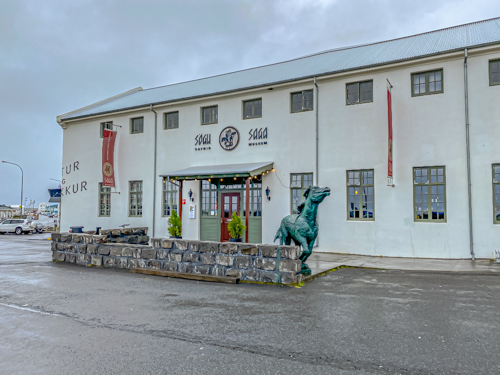
The first museum we saw was the Saga Museum, which tells the story of the settlement of Iceland in a series of vignettes with really lifelike wax figures. Interestingly, the settlement of Iceland largely took place over about a three-hundred year period between about 870 AD and 1066 AD. The Sagas were written later to tell the stories of the settlers. The Saga Museum actually spans a time frame from the early 800s to the Reformation in the mid-1500s.
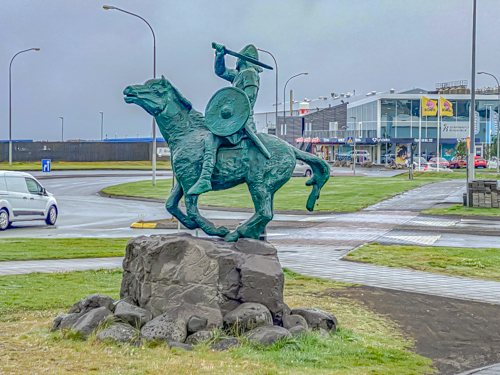
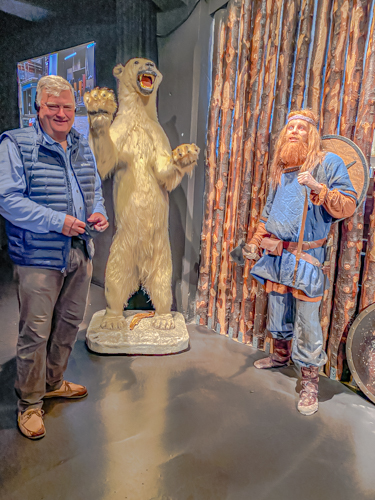
The first record of any inhabitants in Iceland came from the Íslendingbók (the Icelandic Book) written by Ari Thorgilsson in 1122-33. He told of Irish Christians who the Norsemen called “papar” (believed to be Irish monks) who left Iceland when heathen settlers began to occupy the island, purportedly because they couldn’t bear to consort with heathens. They left behind Irish books, as well as crooks and bells, which have been determined to be of Irish origin.
The first to “discover” Iceland from Norway was Floki Vilgerdarson in 870 AD. He set off in his ship from Norway with three ravens aboard, with the thought that he would release them one by one, and he would follow them to land. Unfortunately, the first raven landed in the Faroe Islands, which were already known to Norway. The second raven disappeared entirely. Finally, the third raven led him to Iceland. He was the first to call the island Iceland. Afterwards, he was always known as Hrafna Flóki, which means Raven Flóki.
The first to actually settle in Iceland was a Norwegian captain, Ingólfur Arnason, and his wife, Hallveig Fródadóttir, in the year 874 AD. Icelandic Sagas tell that he threw the carved pillars (side supports) of his throne overboard on the journey from Norway to determine where they should settle. They made landfall in 874 AD, but didn’t find the pillars. After a couple of false starts along the eastern and southern coasts, they pulled into what is now Reykjavik, and found that the pillars had washed ashore there. This has been determined to be the official permanent settlement of Iceland.
Part of what made the Icelandic settlements successful is that early on, the Norsemen discovered that the peat bogs surrounding the coasts of Iceland contained iron deposits, and they developed a process to extract it and to use it to make metal implements. The process was called red-blasting. Fittingly, one of the early stars of the Icelandic Sagas was a smithy called Skalla-Grímur who was able to work out a process to separate the iron deposits from the peat and forge it into iron. Norway had had this technology for about 1,000 years at this time, and it made all the difference in Iceland. Using this process, the impure iron deposits are heated again and again, and the impurities must be beaten out in each cycle. The Sagas tell that Skalla was an ugly brute of a man with almost super-human strength, and that he had to dive deep into the depths of the Reykjavik harbor to bring up a huge rock upon which to pound out the impurities in the iron. If ordinary men had attempted this feat, it would have taken many men to do what Skalla did alone.
Interestingly, although the Norsemen had a written language in the form of runes, almost all of their history and genealogy was kept by oral tradition. Norway was still a non-Christian nation when Iceland was settled. But in 930, Iceland formed a parliament of its chieftains called the Althingi, which met at the Law Rock in Thingvellir. There was a Law Speaker, and in the early years of the Althingi, his role was to memorize and recite all the laws and regulations which had been passed in the preceding year.
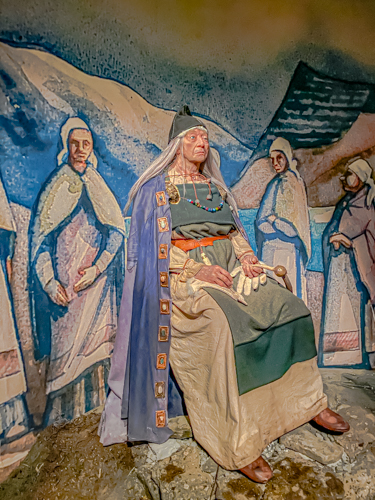
As Europe became increasingly Christianized following the establishment of the Holy Roman Empire about 500 AD, the pressure was on the Nordic countries to convert. Norway finally relented, and the issue came to a head in Iceland in the year 1000 AD. According to the Sagas, one of the wise chieftains who was the leader of the “No on Christianity” faction, Thorgeir Ljosvetninggagodi, said he would “think on it” and retreated to his hut, pulled his blankets over his head (maybe slept a bit), and emerged to decree that all of Iceland would be Christian, henceforth. However, for those who still wished to practice the “old ways”, they just had to do it “privately”.
The rest of the museum dealt with one of the greatest Law Speakers (and writer/poets) Iceland had in the Middle Ages, Snorri Sturlason; the Reformation, and the Icelandic penal system. Did I mention the burning of witches?! Anyway, the museum visit takes abo7ut 45 minutes to an hour.
Our next museum was called the Settlement Exhibition, and it is basically about the excavation of Settlement Era buildings in downtown Reykyjavik. The buildings, including a Norse longhouse, are dated to about 871+/- one year. That is because there was one of Iceland’s perpetual volcanic eruptions in the Akranes peninsula in about 871, the tephra (small volcanic dust and pebbles) covering the site dates to about 871. Think of it as Reykjavik’s own mini-Pompeii. There are actually artifacts from four different excavations sites in this museum, and it is very cool!
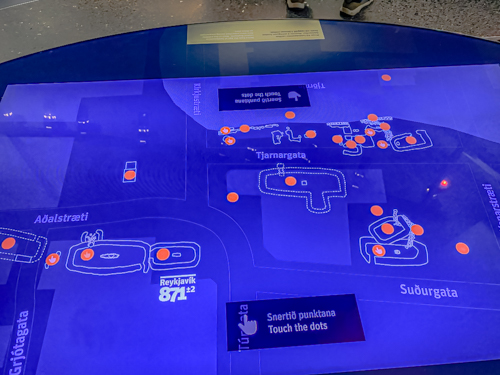
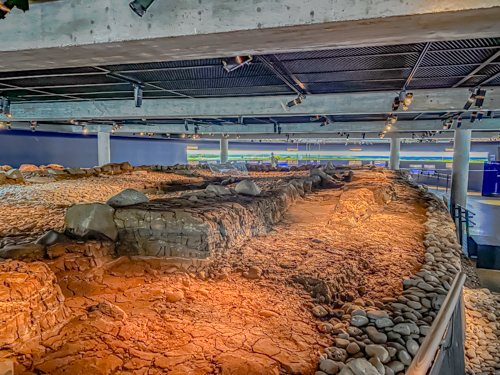
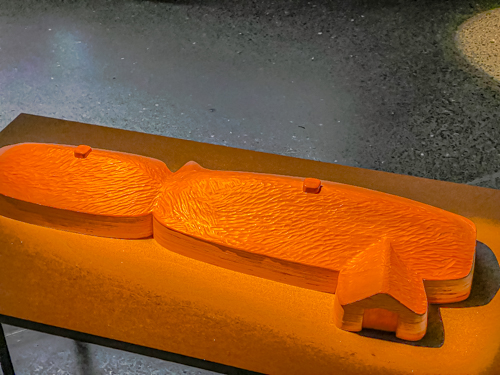
Since we were binging on Icelandic history, we decided to also visit the National Museum of Iceland. We had a long, but very pretty walk from the city center past the big pond next to the City Hall up to the museum. I have to say, it was a little bit of a let-down after the first two museums. For one thing, the organization of the exhibits was a slightly disjointed. However, they had some great artefacts, particularly from the Middle Ages. On the other hand, the emphasis was heavily on the arrival of Christianity in Iceland, which made for a slightly skewed perspective, in my view.
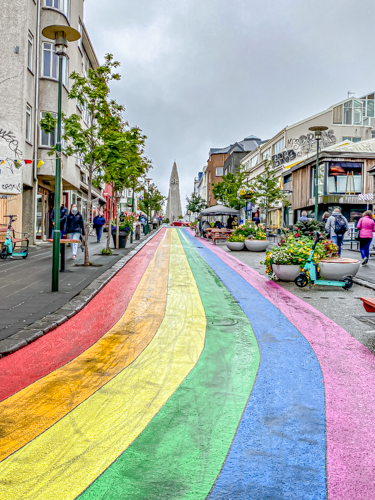
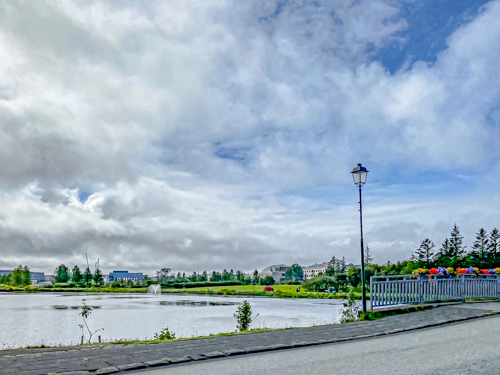
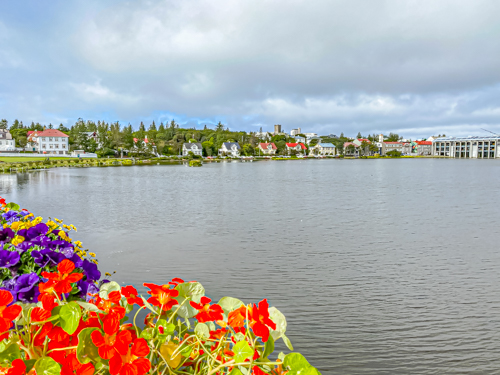
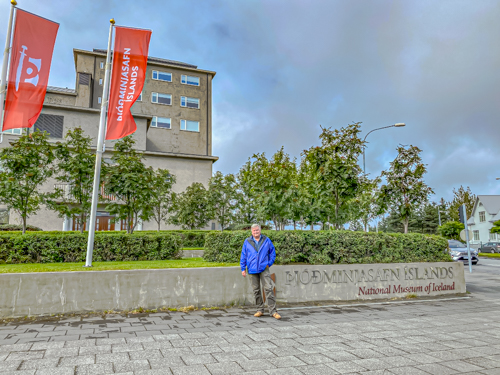
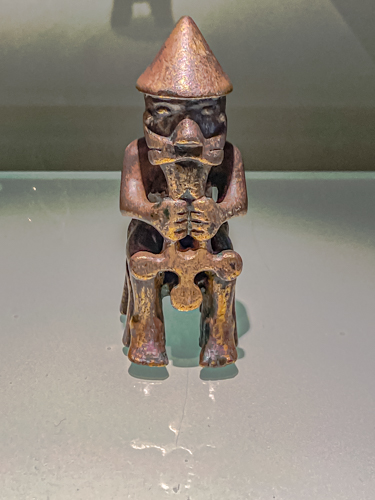
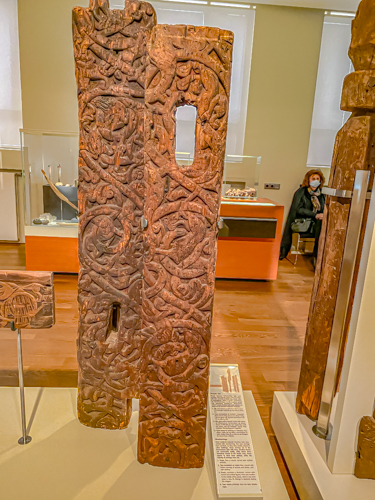
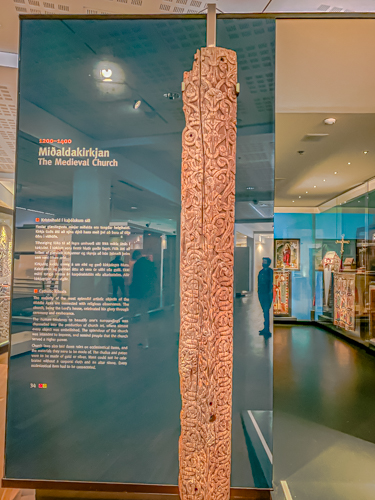
It is fair to say that Jim and I were “museumed-out” by this point. We retired to a great bar/restaurant right in the center of town near the main shopping street, Laugavegur, and had a glass of wine.
Thus recharged, we walked down to our meeting place for our food tour of Reykjavik. We booked the tour through Viator, and the name of the tour provider was The Reykjavik Food Tour. Up front, we knew there were five stops on the tour, and I was just hoping that there would be no pressure to try some of Iceland’s more disgusting food traditions (like fermented shark). I need not have worried. Our tour was led by a lovely modern Icelandic woman named Eyflo. Sadly, it is still possible to order some other “traditional” Icelandic dishes (mostly in Reykjavik) in restaurants which cater to tourists, like puffin and whale, but I believe that with tour guides like Eyflo, tourists will clearly get the message that while Icelanders of olden days ate these dishes to survive when they were on the edge of starvation, our refusal as tourists to sample these dishes will drive them from the menus.
In our first stop, a restaurant in the city center called Fjallkonan, we had a combo plate with two blinis. One was topped with a smokied Arctic char, and the other with a lamb prepared like pulled pork, both had delicious garnishes and were yummy.
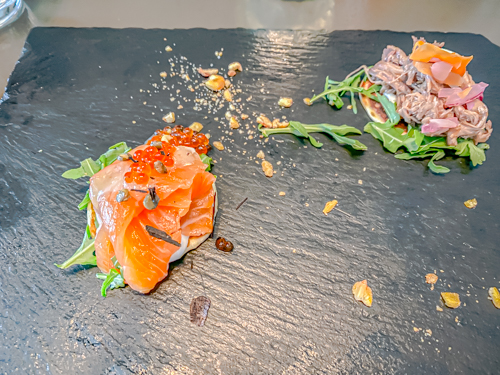
Then we walked to what Eyflo described as the most popular restaurant in Reykjavik. Bill Clinton certainly thought so when he visited during his presidency (and when he was still eating meat). The “restaurant” is a hot dog stand in central Reykjavik called Íslendngar borda SS pylsur. A “pylsur” is a hot dog in Icelandic, and this is the original of what are now several outlets. The classic dog is served with sweet mustard, ketchup, remoulade sauce and crispy fried onions. There is no seating, so we all ate standing up. Oh, did I mention that the hot dog is made from lamb?! Just a side note, unless you want to miss a lot of dishes, this is probably not a great tour for vegetarians.
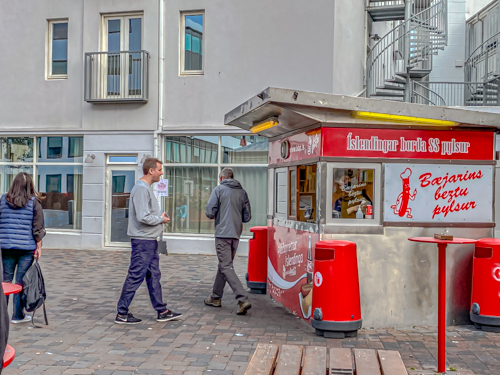

Our third stop was at another classic Reykjavik restaurant called Messinn Seafood Restaurant. The specialty of this restaurant is a variety of seafood dishes served in a hot skillet. It encourages family style dining, and we tried two of their specialties. The first is a kind of fish mash with cod fish, onions, mashed potatoes, and kind of fried and served crispy. I was a little trepidatious, because we had tried a similar dish in Portugal, and it was awful. In both countries, this dish originated as a way to save leftover fish because food was scarce. In Portugal’s case, they cook they whole thing in little crocks in the oven, and it is a fishy mess. In the Icelandic version, it made for a lovely crispy dish, but the fish was probably a lot fresher here than it was in Portugal. The other dish we tried were pan seared Arctic char fillets prepared in butter with almonds slices, small potatoes and onions. Again, it was amazingly fresh and delicious. As a special treat, the dishes were served with traditional Icelandic rye bread, which has a ton of molasses in it, and is more like a dessert than a bread accompaniment.
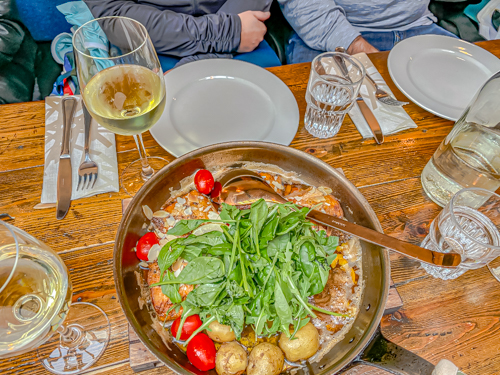
You can see why we were really glad we had passed on lunch today! So off we went to try our fourth sample of Icelandic cuisine. Our fourth stop was at a restaurant called Íslenski Barinn. For this stop, it was all about the traditional Icelandic lamb soup. Eyflo tells us there is a raging dispute about whether you can add tomato paste to the soup (obviously, it was not original), but Icelandic grandmas can almost come to blows over this issue! This is primarily a bar, but most bars in Iceland also have modest food menus. The soup was very hearty, and flavorful, and we were served a quarter pint glass of the local beer with it, Viking.
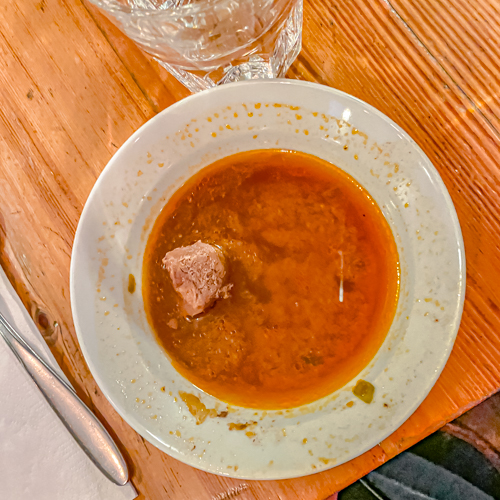
About this time, we’re almost rolling out of the restaurant, so it was really good that Eyflo had us walk up the hill to the most famous church in Reykjavik, Hallsgrimkirka. It is actually just around the corner and up the hill from our hotel, the Canopy. The pedestrian street we walked up is painted in a lovely rainbow, to celebrate Reykjavik’s gay population.
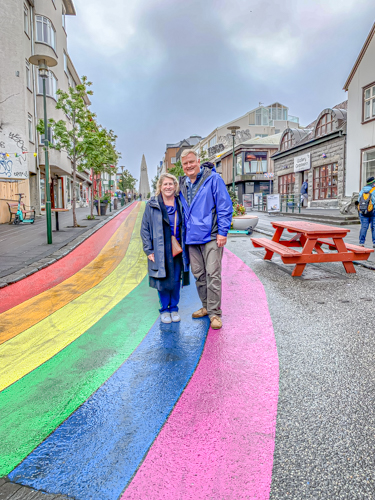
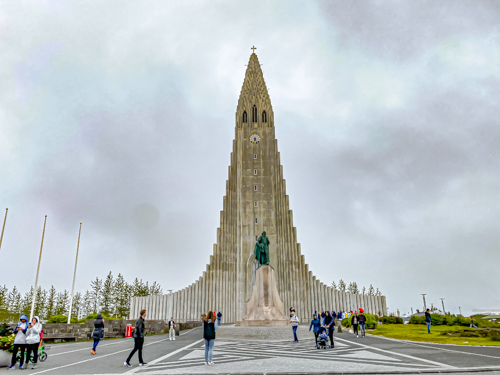
Our final stop of the tour is at the Loki Café. This is our dessert stop, and we have a bizarre couple of dishes to try. On each plate were actually two desserts to sample. One was a traditional Icelandic form of fried bread called a klena. Suffice it to say, it needed more sugar, and to be submerged in a hot liquid, preferably hot chocolate. One bite down, we turned to the star of the show; rye bread ice cream. Again showcasing Icelandic creativity in re-using leftovers, this ice c ream was made traditionally by taking leftover rye bread, adding cream to it, and any other yummy additions you could think of, like chocolate chips, to freeze and make into a dessert. I don’t think anyone left any of this dish behind! One of the better aspects of this stop was that Eyflo gave us permission to ask any questions we had about Iceland. It was a fun and spirited discussion, and I will share some of these tidbits in later posts.
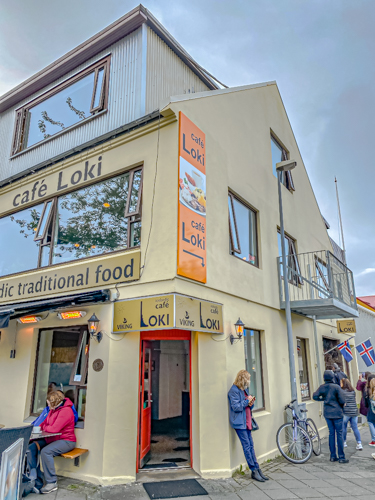

Exhausted, but full, we gave our thanks to Eyflo, and walked home.


So fun to read of your adventures. I love the pics of the houses with the different colored roofs and the history was very interesting to read.
LikeLiked by 1 person
I have spent several hours enjoying your blog on Iceland as I prepare for my own upcoming trip. always love your restaurant choices – and the Food Tour of the city is a WONDERFUL idea. I’ll let you know how the restaurants are fairing in 2024.
LikeLike
I’m so happy you’re enjoying them. The food tour was excellent, but don’t make dinner plans afterward.
LikeLike